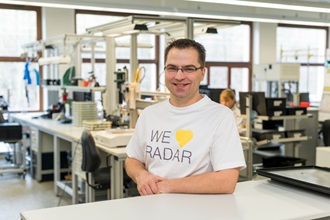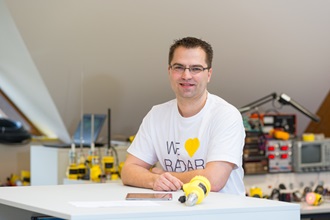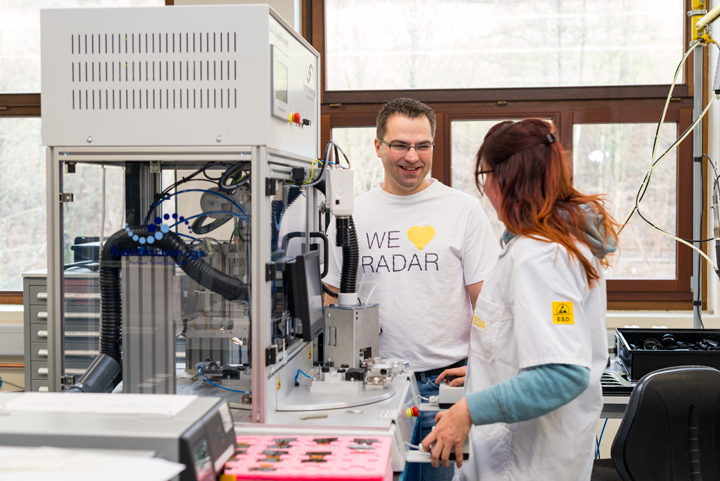Interview: Holger Staiger
I started as a developer at VEGA in September 2000. I already knew the company because I had completed two internship semesters and my diploma thesis at VEGA.
What was your field of activity at that time?
I worked in the area of communication, with a focus on display and adjustment. Not dealing with generating the measured value itself, but displaying it somewhere and passing it on.
That means in principle, you must have accompanied the PLICSCOM display and adjustment module from the very beginning?
Correct, that was my first project. PLICSCOM did not exist at when I joined the company. At that time VEGA were developing the plics® platform that was introduced in 2002. At its heart, it needed a universal plug in display and adjustment module that could be used across all instruments and Technologies.
This idea arose about 2½ years ago. We realized that were able to bring it onto the market relatively quickly due to the modular design of the plics® system. It has resulted in instruments that are much easier to use for customers and also made us stand out clearly from our competition. All of a sudden you don’t have to climb to the top of 20 m-high tanks anymore. You no longer have to cross a river, climb up a ladder or balance over a catwalk – PLICSCOM with Bluetooth lets you adjust the instrument from a safe distance and location. It can also save a lot of time and money.
And nobody else has anything like this, right?
In fact there are some things like this on the market already. I know of competitor field instruments that already had Bluetooth, but they were four wire instruments whose high energy consumption didn’t matter. Our concept was really new for two-wire instruments and across a whole product and multiple Technologies.
In the beginning, when the idea was born, no-one had a vision of these two devices together. VEGAPULS 64 had a much longer development period and required considerably more innovation and know-how. Development engineering management came up with the idea of a PLICSCOM with Bluetooth later, then it had to go very fast.
But this idea has turned out to be a real success. I know that the issue of security was still being discussed at the outset and that our industry is a bit reluctant to use wireless. But was the opposite actually the case?
I’ve heard this and that over the course of time. It's always a question of how you want to deal with it. When you look around today, everybody is using Bluetooth in their private life, hardly anyone thinks about security, although it is an encrypted communication. On the other hand, some industries are (sometimes necessarily) very cautious and will probably delay the use of Bluetooth for many years. However, I think most are already recognizing the advantage of not having to get physically near the measuring instrument to adjust it. I am certain that virtually all will eventually use it. We expect that in the future, we will mainly be selling instruments with Bluetooth.
This additional option for the PLICSCOM, is it much more expensive?
No, the price difference is insignificant. And if you look at the total price of a radar sensor, the cost of PLICSCOM Bluetooth is only a tiny fraction of that. That’s why I think many customers will opt for the Bluetooth function right away.
PLICSCOM with Bluetooth can be used not only with VEGAPULS 64, but with all other VEGA instruments as well, isn't that correct?
Within the plics® instrument platform, it doesn’t matter if it’s a VEGAPULS 69 or a VEGABAR 82 or an even older sensor. That's what the plics® concept is all about.
How far back does this go? How old a sensor can I operate with the new PLICSCOM Bluetooth?
It goes all the way back to 2002. For example, a VEGASON 63 that was sold in 2003 can be equipped with the new Bluetooth PLICSCOM, and it works perfectly.
You just have to exchange that? What about firmware Upgrades?
Its just, old PLICSCOM out, new PLICSCOM in. You can then adjust the instrument as usual via the display or access it via Bluetooth – with the PC and PACTware or even with iOS or Android app using a smartphone or tablet. No firmware changes are needed.
How important are technical achievements like smartphones and tablets to you?
I think it would sound funny if, as an engineer, if I said nobody really needs smartphones or tablets. In reality, more and more people just can’t live without them, including me! They have become an indispensable part of our daily work and private life, from social media to personal finance. There are things that make life a lot easier and simpler, that’s the idea behind plics® too, so why wouldn’t we want to make use of them?
Export this article
Download as PDFShare this article
Comments ({{comments.length}})
{{getCommentAuthor(comment, "Anonymous")}} {{comment.timestamp | date : "dd.MM.yyyy HH:mm" }}
{{comment.comment}}





